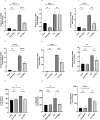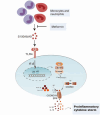Metformin Mitigates Sepsis-Induced Acute Lung Injury and Inflammation in Young Mice by Suppressing the S100A8/A9-NLRP3-IL-1β Signaling Pathway
- PMID: 38895139
- PMCID: PMC11182881
- DOI: 10.2147/JIR.S460413
Metformin Mitigates Sepsis-Induced Acute Lung Injury and Inflammation in Young Mice by Suppressing the S100A8/A9-NLRP3-IL-1β Signaling Pathway
Abstract
Background: Globally, the subsequent complications that accompany sepsis result in remarkable morbidity and mortality rates. The lung is among the vulnerable organs that incur the sepsis-linked inflammatory storm and frequently culminates into ARDS/ALI. The metformin-prescribed anti-diabetic drug has been revealed with anti-inflammatory effects in sepsis, but the underlying mechanisms remain unclear. This study aimed to ascertain metformin's effects and functions in a young mouse model of sepsis-induced ALI.
Methods: Mice were randomly divided into 4 groups: sham, sham+ Met, CLP, and CLP+ Met. CLP was established as the sepsis-induced ALI model accompanied by intraperitoneal metformin treatment. At day 7, the survival state of mice was noted, including survival rate, weight, and M-CASS. Lung histological pathology and injury scores were determined by hematoxylin-eosin staining. The pulmonary coefficient was used to evaluate pulmonary edema. Furthermore, IL-1β, CCL3, CXCL11, S100A8, S100A9 and NLRP3 expression in tissues collected from lungs were determined by qPCR, IL-1β, IL-18, TNF-α by ELISA, caspase-1, ASC, NLRP3, P65, p-P65, GSDMD-F, GSDMD-N, IL-1β and S100A8/A9 by Western blot.
Results: The data affirmed that metformin enhanced the survival rate, lessened lung tissue injury, and diminished the expression of inflammatory factors in young mice with sepsis induced by CLP. In contrast to sham mice, the CLP mice were affirmed to manifest ALI-linked pathologies following CLP-induced sepsis. The expressions of pro-inflammatory factors, for instance, IL-1β, IL-18, TNF-α, CXCL11, S100A8, and S100A9 are markedly enhanced by CLP, while metformin abolished this adverse effect. Western blot analyses indicated that metformin inhibited the sepsis-induced activation of GSDMD and the upregulation of S100A8/A9, NLRP3, and ASC.
Conclusion: Metformin could improve the survival rate, lessen lung tissue injury, and minimize the expression of inflammatory factors in young mice with sepsis induced by CLP. Metformin reduced sepsis-induced ALI via inhibiting the NF-κB signaling pathway and inhibiting pyroptosis by the S100A8/A9-NLRP3-IL-1β pathway.
Keywords: ALI; inflammation; pediatric; pyroptosis; sepsis.
© 2024 Fan et al.
Conflict of interest statement
The authors report no potential conflicts of interest in this work.
Figures






References
LinkOut - more resources
Full Text Sources
Miscellaneous

